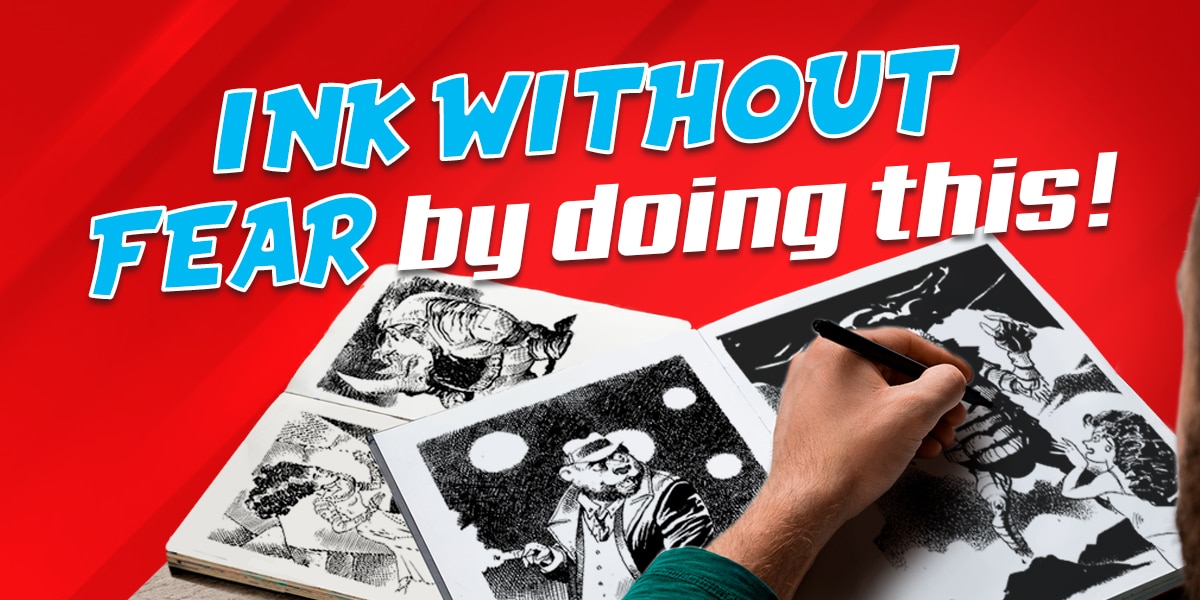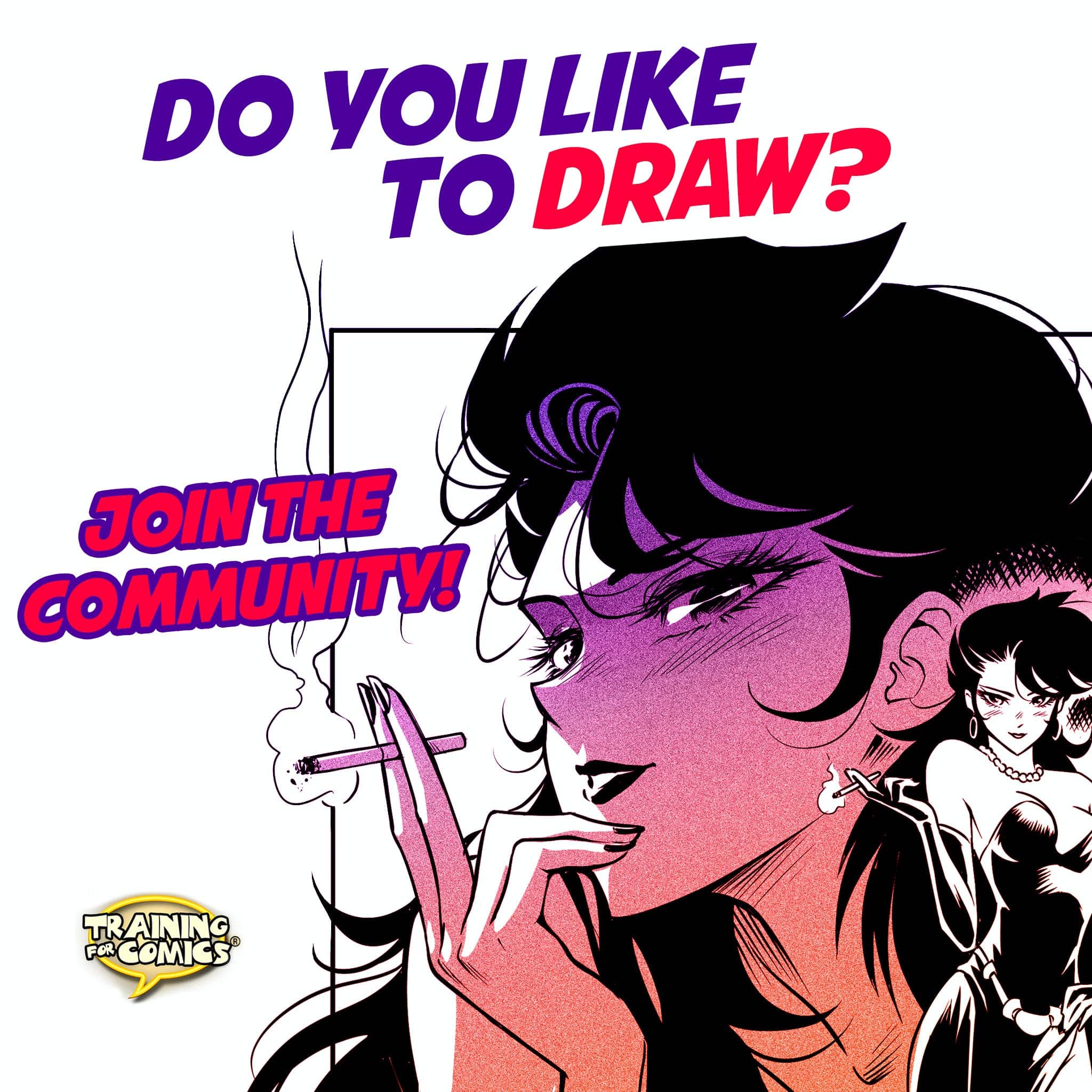INK WITHOUT FEAR: Discover the Art of Bringing Your Drawings to Life
Have you ever felt that your pencil drawings lose their magic when you ink them? Do you find yourself hesitating every time you pick up a brush or pen? Fear no more! In this article, we’ll immerse you in the fascinating world of inking, revealing secrets and techniques that will transform the way you see and execute this art. Get ready to unleash your creativity, overcome your fears, and discover a new level in your illustrations. Keep reading and take the leap your art deserves!
Inking: Much More Than Tracing Your Pencil Drawing
Inking is an art in itself, a delicate dance between precision and creativity. Far from being a simple act of tracing, it’s the crucial moment where your illustration or comic truly comes to life. This is where the magic happens, where timid pencil strokes transform into bold ink statements.
For this process to be truly rewarding, it’s essential to free yourself from the idea of exactly reproducing what you drew in pencil. Instead, consider your sketch as a map, a guide that orients you but doesn’t limit you. This mindset will allow you to explore, experiment, and yes, even make mistakes and correct them. Remember, each ink stroke is an opportunity to improve and redefine your original vision.
When inking, you’ll notice differences from your pencil drawing. This is normal and desirable! Don’t get frustrated; celebrate these differences as part of the creative process. Ink has its own language, its own way of expressing volume, texture, and emotion. Embrace it and discover how to take your illustrations to the next level by clicking here.
Your main tools will be the pen and brush. Each has its own characteristics and expressive potential. Experiment with them, find the most comfortable way to handle them. Comfort in handling your tools will translate into more confident and expressive lines.

Observe how the pencil provides the skeleton of the page, but inking gives it life and its own character. The lines, tones, texture… everything changes and is enriched in the inking process. This is the moment to let your creativity flow and give your work a unique personality.
Free Your Hand: Exercises to Master the Art of Inking
To develop confidence and skill in inking, it’s crucial to practice regularly. Here I present a series of exercises designed to free your hand and foster creativity in the inking process:
- From Sketch to Ink: Start with simple pencil sketches, focusing only on basic structures. Then, move directly to ink to add details, textures, and shadows. This exercise will help you develop confidence to work directly with ink.
- Direct Inking: Create drawings completely in ink, without a prior sketch. Start with abstract shapes and gradually add complexity. This approach will force you to think in terms of ink from the beginning.
- Black and White Play: Use black India ink and white acrylic (or tempera) to create contrast. Paint areas in black and then add details in white. This exercise will teach you to think in terms of light and shadow.

In this image, observe how the use of white on black creates a dramatic effect and adds depth to the illustration. This technique is especially useful for creating intricate textures and patterns.
Pro Tip: Don’t be afraid to use white to correct or add details. The combination of black and white offers you a world of creative possibilities. Explore more advanced inking techniques here and take your illustrations to another level.
The Power of Black and White: Beyond Limits
Inking reduces your palette to two colors: black and white. But don’t be fooled by this apparent limitation. In reality, this duality opens up a universe of creative possibilities waiting to be explored.

Observe the richness of textures and tones that can be achieved with just black and white. Each line, each dot, each area of shadow contributes to creating a dynamic and expressive image.
The art of inking is based on the masterful combination of lines and planes (or points, lines, and planes, as Kandinsky would say). The line, in particular, is a vital expressive resource. It’s the backbone of your work, capable of conveying emotion, movement, and depth.
To master the art of line, I suggest the following:
- Study and copy the work of your favorite artists. Analyze how they use line to create different effects.
- Experiment with different types of lines: neat, expressive, loose, broken, quick…
- Play with the thickness and modulation of lines to create depth and emphasis.
Remember, the goal is not just to reproduce, but to find your unique voice. Want to discover your personal style in inking? Click here to explore more.
Experiment, Play, and Have Fun: The Key to Success
The secret to mastering inking is not just in technique, but in the attitude with which you approach it. Experimentation, play, and fun are crucial elements in your artistic development.

This image shows different inking techniques. Observe how each style creates a unique feeling and atmosphere. The key is to experiment and find what works best for your personal style.
To help you on your journey of experimentation, I propose the following exercises:
- Texture Squares: Create several squares and fill them with different types of lines (thin, thick, curved, straight). Experiment with the direction, speed, and pressure of your strokes.
- Grayscale: Draw a series of 5 squares, from pure white to solid black, creating a gradual scale of grays in between. Use different techniques to achieve the intermediate tones.
- Tool Combination: Create a drawing using both pen and brush. Use thicker lines for foreground elements and thinner ones for backgrounds, thus creating depth in your illustration.
These exercises will not only improve your technique but also help you discover new forms of expression. Ready to take your inking to the next level? Discover more advanced exercises here.
The Plane: Your Ally in Visual Expression
While the line is the backbone of your inking, the plane is the muscle that gives it shape and volume. Black and white planes are powerful tools for creating depth, contrast, and atmosphere in your illustrations.
Generate Graduated Tones: The Art of Subtlety
Creating graduated tones is an essential skill in inking. It allows you to add depth and dimension to your drawings, creating smooth transitions between white and black. Here are some techniques to explore:
- Hatching: Parallel lines to create shadows and textures.
- Cross-hatching: Overlapping lines at different angles to achieve darker tones.
- Stippling: Use of dots to create gradients and textures.
- Scumbling: Overlapping circular strokes to create organic textures.
Experiment with these techniques to create a variety of tones, from the subtlest to high contrast. Each style communicates a different feeling to the viewer, so choose the one that best suits the atmosphere you want to create in your work.
Advanced Exercises: Take Your Inking to the Next Level
To continue developing your skills, I propose these more advanced exercises:
- High Contrast: Take a previous drawing and transform it into a high contrast version. Remove all contour lines and define shapes solely through the contrast between black and white. This exercise will help you think in terms of light and shadow, beyond lines.
- Tonal Variety without Lines: Using the same drawing, create a version that completely dispenses with contour lines. Instead, generate a variety of tones using the grid techniques you’ve practiced. This will challenge you to think about volumes and shapes in a completely new way.

In this image, you can see how the use of high contrast and tonal variety can create impactful images without relying on contour lines. Observe how light and shadow define shapes and create depth.
These exercises will help you see beyond lines and think in terms of masses and volumes. Want to further perfect these advanced techniques? Discover additional resources here.
Unleash Your Creativity: Inking as a Creative Process
It’s crucial to understand that inking is not simply the final phase of your work, but a creative stage in its own right. Don’t limit yourself to faithfully copying your pencil sketch. Instead, consider inking as an opportunity to expand and improve your original idea.
Here are some ways to approach inking creatively:
- Experiment with different line thicknesses to emphasize certain elements.
- Add textures and patterns that weren’t in your original sketch.
- Play with contrast to create focal points.
- Use shading techniques to add depth and volume.
Remember, inking is not just black on white, it’s the harmonious dance of both. Each stroke, each area of black or white, is a creative decision that impacts the visual narrative of your work.
Conclusion: Your Journey in the Art of Inking
Inking is an art that combines technical skill with creative expression. Throughout this article, we’ve explored various techniques and exercises designed to help you master this fascinating aspect of illustration. From the importance of freeing your hand to the expressive power of black and white, each section has provided you with tools to improve your art.
Remember, the key to success in inking lies in constant practice and the willingness to experiment. Don’t fear making mistakes; each stroke is an opportunity for learning and growth. Use the proposed exercises as a starting point, but don’t hesitate to adapt them and create your own.
Inking is a journey of personal and artistic discovery. As you develop your skills, you’ll find your unique style and voice as an artist. Enjoy the process, celebrate your achievements, and never stop challenging yourself.
Now, armed with this knowledge and techniques, you’re ready to dive into the fascinating world of inking. Remember that every line you draw, every shadow you create, is an expression of your unique artistic vision. Don’t be afraid to experiment, make mistakes, and learn from each experience.
I invite you to review this article periodically, especially when facing new challenges in your art. Each time you read it, you may discover new nuances and apply the advice differently, as your skill and understanding grow.
Ready to take your inking art to the next level? Click here to discover additional resources and advanced techniques that will help you perfect your style and expand your creative horizons.
Remember, inking is more than a technique; it’s a form of artistic expression. With practice, patience, and passion, you’ll see how your illustrations come to life in ways you never imagined. Go ahead, pick up your pen or brush, and start creating magic in black and white!



